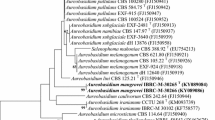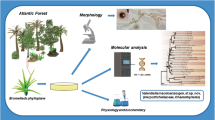Abstract
During a study of microorganisms associated with maize (Zea mays) cultivation, yeasts were isolated from overwintered stalks, cobs and surrounding soil, which were collected from an agricultural field in south-central Illinois, USA. Predominant among isolates were two species of Cryptococcus (Cr. flavescens, Cr. magnus) and a red yeast that D1/D2 LSU rRNA gene sequences revealed to be a new species of the basidiomycete yeast genus Occultifur. The species, which was not detected in the same field during the growing season, is described here as Occultifur kilbournensis (MycoBank number MB 811259; type strain NRRL Y-63695, CBS 13982, GenBank numbers, D1/D2 LSU rRNA gene, KP413160, ITS, KP413162; allotype strain NRRL Y-63699, CBS 13983). Mixture of the type and allotype strains resulted in formation of hyphae with clamp connections and a small number of apparent basidia following incubation on 5 % malt extract agar at 15 °C for 2 months. In view of the uncertainty of the life cycle, the new species is being designated as forma asexualis. From analysis of D1/D2 and ITS nucleotide sequences, the new species is most closely related to Occultifur externus.


Similar content being viewed by others
References
Burmeister HR, Hartman PA (1966) Yeasts in ensiled high-moisture corn. Appl Microbiol 14:35–38
Gomes FCO, Safar SVB, Marques AR, Medeiros AO, Santos ARO, Carvalho C, Lachance MA, Sampaio JP, Rosa CA (2015) The diversity and extracellular enzymatic activities of yeasts isolated from water tanks of Vriesea minarum, an endangered bromeliad species in Brazil, and the description of Occultifur brasiliensis f.a., sp. nov. Antonie van Leeuwenhoek 107:597–611
Hesseltine CW, Bothast RJ (1977) Mold development in ears of corn from tasseling to harvest. Mycologia 69:328–340
Horn BW (1985) Association of Candida guilliermondii with amylolytic filamentous fungi on pre-harvest corn. Can J Microbiol 31:19–23
Khunnamwong P, Surussawadee J, Jindamorakot S, Ribeiro JR, Hagler AN, Limtong S (2015) Occultifur tropicalis f.a., sp. nov., a novel Cystobasidiomycetous yeast species isolated from tropical regions. Int J Syst Evol Microbiol. doi:10.1099/ijs.0.000140
Kurtzman CP, Robnett CJ (1998) Identification and phylogeny of ascomycetous yeasts from analysis of nuclear large subunit (26S) ribosomal DNA partial sequences. Antonie van Leeuwenhoek 73:331–371
Kurtzman CP, Robnett CJ (2003) Phylogenetic relationships among yeasts of the “Saccharomyces complex” determined from multigene sequence analyses. FEMS Yeast Res 3:417–432
Kurtzman CP, Fell JW, Boekhout T, Robert V (2011) Methods for isolation, phenotypic characterization and maintenance of yeasts. In: Kurtzman CP, Fell JW, Boekhout T (eds) The yeasts, a taxonomic study, 5th edn. Elsevier, Amsterdam, pp 87–110
Nout MJR, Platis CE, Wicklow DT (1997) Biodiversity of yeasts from Illinois maize. Can J Microbiol 43:362–367
Pan J, May GM (2009) Fungal-fungal associations affect the assembly of endophyte communities in maize (Zea mays). Microb Ecol 58:668–678
Papavizas GC, Davey CB (1959) Evaluation of various media and antimicrobial agents for isolation of soil fungi. Soil Sci 88:112–117
Sampaio JP, Oberwinkler F (2011a) Cystobasidium (Lagerheim) Neuhoff (1924). In: Kurtzman CP, Fell JW, Boekhout T (eds) The yeasts, a taxonomic study, 5th edn. Elsevier, Amsterdam, pp 1419–1422
Sampaio JP, Oberwinkler F (2011b) Occultifur Oberwinkler (1990). In: Kurtzman CP, Fell JW, Boekhout T (eds) The yeasts, a taxonomic study, 5th edn. Elsevier, Amsterdam, pp 1515–1518
Sampaio JP, Bauer R, Begerow D, Oberwinkler F (1999) Occultifur externus sp. nov., a new species of simple-pored auricularioid heterobasidiomycete from plant litter in Portugal. Mycologia 91:1094–1101
Tamura K, Peterson D, Peterson N, Stecher G, Nei M, Kumar S (2011) MEGA5: molecular evolutionary genetics analysis using maximum likelihood, evolutionary distance, and maximum parsimony methods. Mol Biol Evol 28:2731–2739
Yurkov AM, Kachalkin AV, Daniel HM, Groenewald M, Libkind D, de Garcia V, Zalar P, Gouliamova DE, Boekhout T, Begerow D (2015) Two yeast species Cystobasidium psychroaquaticum f.a. sp. nov. and Cystobasidium rietchieii f.a. sp. nov. isolated from natural environments, and the transfer of members of Rhodotorula minuta clade to the genus Cystobasidium. Antonie van Leeuwenhoek 107:173–185
Acknowledgments
We thank Andrey M. Yurkov, José Paulo Sampaio, Carlos A. Rosa and Teun Boekhout for comments on classification of the Cystobasidiales and for sharing unpublished data, Nathane Orwig for sequence determinations and Donald T. Wicklow and Jacob Brown for providing some of the field samples examined. The mention of trade names or commercial products in this publication is solely for the purpose of providing specific information and does not imply recommendation or endorsement by the U.S. Department of Agriculture. The USDA is an equal opportunity provider and employer.
Author information
Authors and Affiliations
Corresponding author
Electronic supplementary material
Below is the link to the electronic supplementary material.
10482_2015_427_MOESM1_ESM.docx
Fig. S1. Placement of Occultifur kilbournensis among members of the Cystobasidiales as determined from maximum likelihood analysis (HKY + G) of ITS nucleotide sequences. Rhodotorula glutinis and R. mucilaginosa were the designated outgroup species in the analysis. Bootstrap values (1000 replicates) >50 % are given at branch nodes. GenBank numbers follow strain numbers. Strain accession numbers: AS, Academia Sinica, Beijing, China; CBS, Centraalbureau voor Schimmelcultures, Utrecht, The Netherlands; DMKU, S. Limtong, Thailand; IMUFRJ, Instituto de Microbiologia Prof. Paulo de Góe, Federal University of Rio de Janeiro; JCM, Japan Collection of Microorganisms, Tsukuba, Japan; NRRL, ARS Culture Collection, Peoria, Illinois, USA; UFMG = Universidade Federal de Minas Gerais Culture Collection, Brazil. The newly described species Cystobasidium psychroaquaticum and C. rietchieii (Yurkov et al. 2015) were not included in the analysis. Type strains are indicated by a superscript T and superscript A indicates an authentic strain
Rights and permissions
About this article
Cite this article
Kurtzman, C.P., Robnett, C.J. Occultifur kilbournensis f.a. sp. nov., a new member of the Cystobasidiales associated with maize (Zea mays) cultivation. Antonie van Leeuwenhoek 107, 1323–1329 (2015). https://doi.org/10.1007/s10482-015-0427-1
Received:
Accepted:
Published:
Issue Date:
DOI: https://doi.org/10.1007/s10482-015-0427-1




